| |

Traditions, folklore, history and more. If it's Irish, it's here. Or will be!
"People will not look forward to posterity who never look backward to their ancestors."
-Edmund Burke




Quotes
Library: Books, Movies, Music
Prints & Photos
Poetry
Jokes


Shops Ireland
Bunús na Gaeilge
(Basic Irish)
Circle of Prayer
Blessings
Did You Know?
Himself/Herself
Write to Us
Readers Write..
Links/Link to Us
Advertise with us
Awards & Testimonials
Submissions Guide

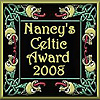
|
|
|
The Holy Wells of Ireland
by Bridget Haggerty
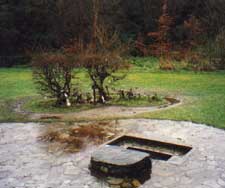 About 60 years ago, a survey claimed there were as many as 3,000 holy wells in Ireland - more than in any other country in the world. Where once a pagan sacrifice may have taken place, today a bride might look into the waters for good luck - or a cripple might bathe in them, hoping for a cure. About 60 years ago, a survey claimed there were as many as 3,000 holy wells in Ireland - more than in any other country in the world. Where once a pagan sacrifice may have taken place, today a bride might look into the waters for good luck - or a cripple might bathe in them, hoping for a cure.
In Irish myth, wells and springs are depicted as originating in the Otherworld - that parallel dimension whose inhabitants have the power to control the natural forces of this world. From sources in the Otherworld, water flows into our world to fill springs or gush forth as rivers such as the Boyne and Shannon. These bodies of water and others are closely identified with goddesses - Bóann and Sionann, for example, who are thought to be part of the water's flow. Such sacred water sources are also often linked to the fruit of certain trees, such as the hazelnut.
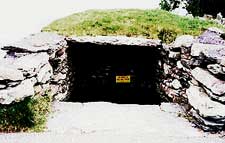 It was believed that drinking from these holy waters or bathing in them would bestow the power of the Otherworld in the form of poetic inspiration, wisdom, or healing. Supernatural fish, especially salmon or trout, are still said to appear in a well's depths to those seeking omens for the future. The fish motif may derive from a belief that well goddesses could take the form of a fish. Also, salmon were often credited with being bearers of "iomas" - the "light that illumines" - meaning the insight and wisdom that comes from a supernatural encounter, rather than the knowledge acquired through conventional study. It was believed that drinking from these holy waters or bathing in them would bestow the power of the Otherworld in the form of poetic inspiration, wisdom, or healing. Supernatural fish, especially salmon or trout, are still said to appear in a well's depths to those seeking omens for the future. The fish motif may derive from a belief that well goddesses could take the form of a fish. Also, salmon were often credited with being bearers of "iomas" - the "light that illumines" - meaning the insight and wisdom that comes from a supernatural encounter, rather than the knowledge acquired through conventional study.
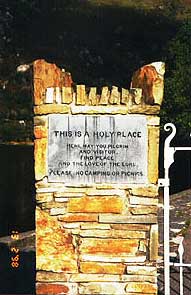 In pagan Ireland, the wells were visited at special times of the year: Imbolc on February 1, Beltaine on May 1, Lughnasa on August1 and Samhain on November 1. These were all special turning-points of the Celtic year when the gates of the Otherworld were opened. This is especially true for Samhain, where the veil between the living and the dead was at its thinnest point, and often visions of the good people were seen in sacred places. In pagan Ireland, the wells were visited at special times of the year: Imbolc on February 1, Beltaine on May 1, Lughnasa on August1 and Samhain on November 1. These were all special turning-points of the Celtic year when the gates of the Otherworld were opened. This is especially true for Samhain, where the veil between the living and the dead was at its thinnest point, and often visions of the good people were seen in sacred places.
Elements of pre-Christian Celtic religion persist in the configuration of holy well sites and the practices that have been performed for generations. Surveys of well sites by researchers such as Walter and Mary Brenneman indicate that many sites actually consist of three elements: the well, spring, or other water source; a sacred tree - usually very large and very old; and a hill or standing stone. These features played a part in the prescribed rituals for pilgrims who came to the sites seeking favors. These were called "patterns" and almost always included some sort of circular walk, always done "deiseal" - in the same direction in which the sun travels.
See Pattern Day in Old Ireland
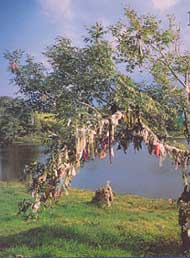 In some places, additional ritual actions may have made use of the site's specific features. For example, many well sites include a large stone that has a depression in it. Those large enough to hold a person were often called "beds"; women would lie on such stones to ensure conception and birth of children. Other objects - such as standing stones or statues - were rubbed to obtain a blessing. One of the most common practices was to tie a strip of cloth - a clootie - to the holy tree after washing, bathing, or drinking from the well. This practice was thought to drive illness into the cloth that is left behind. In some places, a pin or coin was tossed into the well as an offering. The Well of the Wether's, a St. Patrick's well in Ardfert, Co. Kerry contains an altar showing "saints" heads worn from rubbing and ritually incised for healing. St. Ciaran's Well at Clonmacnoise, Co. Offaly contains three stone heads that are routinely kissed and marked as pilgrims make their rounds or "patrons." A booley (Buaile, dairy or milking) stone activates St. Erc's Well at Listowel, Co. Kerry; the well is also marked by a pre-Christian standing stone. In some places, additional ritual actions may have made use of the site's specific features. For example, many well sites include a large stone that has a depression in it. Those large enough to hold a person were often called "beds"; women would lie on such stones to ensure conception and birth of children. Other objects - such as standing stones or statues - were rubbed to obtain a blessing. One of the most common practices was to tie a strip of cloth - a clootie - to the holy tree after washing, bathing, or drinking from the well. This practice was thought to drive illness into the cloth that is left behind. In some places, a pin or coin was tossed into the well as an offering. The Well of the Wether's, a St. Patrick's well in Ardfert, Co. Kerry contains an altar showing "saints" heads worn from rubbing and ritually incised for healing. St. Ciaran's Well at Clonmacnoise, Co. Offaly contains three stone heads that are routinely kissed and marked as pilgrims make their rounds or "patrons." A booley (Buaile, dairy or milking) stone activates St. Erc's Well at Listowel, Co. Kerry; the well is also marked by a pre-Christian standing stone.
Many Christian churches were constructed near pagan wells, and the early Celtic church used them for baptism until the Roman church replaced them with the font inside the building. A number of old churches contain a crypt or grotto that opens into a subterranean spring. This place - close to earth and water - is the innermost sanctum, the hidden holy center of the sacred enclosure.
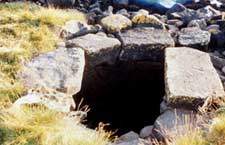 Holy wells exist in most counties of Ireland and a brief list has been included at the end of this article. While many of the old wells have fallen into disrepair, interest in the history and heritage associated with these ancient sites has been revived and there are many people now actively attempting to restore them. One group in particular, The Living Water Workshop, has already mapped 1,300 holy wells and is seeking volunteers to help them continue their work. Interested? Mo Griffith at Sraughan, Lackan, Blessington, Co. Wicklow would love to hear from you! Holy wells exist in most counties of Ireland and a brief list has been included at the end of this article. While many of the old wells have fallen into disrepair, interest in the history and heritage associated with these ancient sites has been revived and there are many people now actively attempting to restore them. One group in particular, The Living Water Workshop, has already mapped 1,300 holy wells and is seeking volunteers to help them continue their work. Interested? Mo Griffith at Sraughan, Lackan, Blessington, Co. Wicklow would love to hear from you!
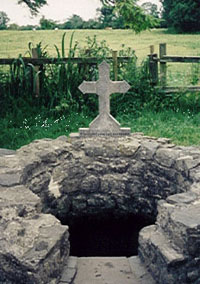 In the course of our research, we also found a great website put together by Geoff Burton who has published a digital version of a book called "The Holy Wells of Ireland" written by Philip Dixon Hardy and first published in 1836. To quote Geoff: “Stereotypes and prejudices abound - it is looking at Catholic pilrimages to holy wells from a staunchly and vituperatively Protestant perpective. Despite this, there are many passages which give real historical insights into the processes and character of the traditions...” Just a brief perusal of the first few pages corroborates Geoff's opinion; however, it does offer a rare glimpse of spiritual life in Ireland in the mid 19th century. If you're interested in reading the book, here's the link: Geoff Burton - Wells. In the course of our research, we also found a great website put together by Geoff Burton who has published a digital version of a book called "The Holy Wells of Ireland" written by Philip Dixon Hardy and first published in 1836. To quote Geoff: “Stereotypes and prejudices abound - it is looking at Catholic pilrimages to holy wells from a staunchly and vituperatively Protestant perpective. Despite this, there are many passages which give real historical insights into the processes and character of the traditions...” Just a brief perusal of the first few pages corroborates Geoff's opinion; however, it does offer a rare glimpse of spiritual life in Ireland in the mid 19th century. If you're interested in reading the book, here's the link: Geoff Burton - Wells.
Throughout this article, we have been referring to the customs associated with Ireland's sacred waters as if they are now a part of our history. Not so. Today, Irish Catholics often make pilgrimages to wells and many of the customs, including attaching clooties to tree branches, are still carried out. We found a charming essay written by a primary school girl who attends Our Lady of Lourdes National School in Bunclody, Co. Wexford.
Holy Wells
by Maureen Berry (6th Class)
"We go to holy wells in the summer and in the winter. We go to pray for other people and for ourselves. Holy wells are very special. Some wells are very important to other people, too. The names of the some of the wells we visit are St. Ann’s Well in Killanne in Wexford and Our Lady’s Well up the Half-Way Road outside Bunclody, St. Kevin’s Well in Wicklow, St. Patrick’s Well in Rathvilly Co. Carlow, St. Bridget’s Well in Myshall Co. Carlow and St. David’s Well in Oylegate in Co. Wexford.
God blesses Holy Wells. Sometimes you can see visions in the well. Lots of people go to visit them a lot of time. We don’t have special prayers for each well, we just go to pray if something is gone wrong. Holy wells are called holy wells because Saints are seen there. And some people go to pray when things go wrong for them.
The holy water from some of the wells cures people. My sister’s hair began to fall out. She went to St. Kevin’s Well and now her hair is all grown back. My aunt had a problem. She went to Mt. Mellary and her problem was solved.
In many places, rags, handkerchiefs or clothes are tied to the trees above or around the well. The idea about this custom is that as the rag rots away, so does your illness."
Maureen is part of the Traveller community. Traditionally, Travellers are very devout Catholics who regularly visit holy wells all over Ireland, including St. Brigid’s Well in Kilranelagh parish, Co.Carlow, and Tubber-macduach which is a quarter of a mile from Kinvarra in Co. Galway. If you'd like to visit her school's website, which is a lot of fun to explore, please click Bunclodyns.
And, if you'd like to visit a well yourself, consider adding one or more of the following locations to your itinerary:
CLARE
St. Brigid's Well - Liscannor
Magh Adhair - Quin
Eye Well - Burren
Tooth Well - Burren
Margaret's Well - Ennis
St. Augustine's Well - Kilshanny
CORK
St. Olan's Well - Aghbullogue
Tobrid Well - Millstreet
Ballinspittle
Inchigeela
Sunday's Well and Mary's Well - Walshestown
St. Finbar's Well, Gougane Barra
DONEGAL
Doon Well, Kilmacrennan
KERRY
Well of the Wethers - Ardfert
St. Dahlin's - Ballyheige
St. John's Well - Dingle
St. Erc's Well - Listowel
St. Eoin's Well - Listowel
St. Michael's Well - Ballymore West
Lady Well - Ballyheige
KILDARE
Earl's Well - Kildare
St. Brigid's Well - Kildare
Father Moore's Well - Kildare
MEATH
Tobar Patraic - Ardmulchan
St. John's Well - Warrenstown
Tara (Neamnach, Toberfin, and Leacht) - Castlebye
ROSCOMMON
Tober Oglalla - Tulsk
St. Lassair's Well - Lough Meelagh
St. Attracta's Well - Monasteraden
SLIGO
Tobernault - Sligo
St. Brigid's Well - Cliffony
Tullaghan Well - Tullaghan
St. Patrick's Well - Dromard
St. Patrick's Well - Aughris
The Bog - The Culleens
Lead photograph: Doon well, Kilmacrennan, Co.Donegal. One of the most famous wells in Ireland. A circular path is worn around the two thorn trees by the stations of pilgrims. Crutches have been left behind in thanks, as a sign of healing.
Resources:
Content:
Francine Nicholson, M.A.
Suzanne Barrett
Tracy
The Living Water Workshop
Images:
St. Finnbars Well & Sign by Dr. Deborah Vess
St Feidhlimh's holy well & Doon Well
|
|
Fri, Sep 27, 2024
 The Galway Hooker The Galway Hooker
This unique vessel, with its distinctive curved lines and bright red sails, originated in the village of Claddagh. During the 19th century, hookers supported a significant fishing industry and also carried goods, livestock and fuel. Seán Rainey is remembered for building the last of the original boats, the Truelight, for Martin Oliver who was to become the last king of the Claddagh; as king, he was entitled to white sails on his boat. Since the mid seventies, many of the old sailing craft which were on the verge of extinction have been lovingly restored and new ones have been built. During the summer months they can be seen at festivals such a Cruinniú na mBád - the Gathering of the Boats - in Kinvara.
Click for More Culture Corner.
The former editor of Ireland's tourism magazine, Ireland of the Welcomes, Elizabeth Healy is an expert on Ireland with a deep love of her subject. Originally from Cork, she now lives in Dublin, and works as a freelance journalist.
Click here for Holy Wells.
|
|
|
|
|




 The Galway Hooker
The Galway Hooker